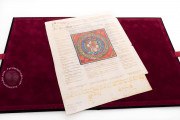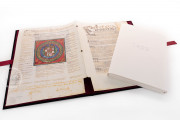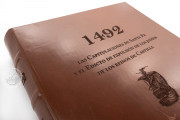The Treaty of Granada, Decree of Expulsion of the Jews, and Santa Fe Capitulations is a collection of documents that casts light on the early modern history of the Iberian Peninsula. All three relate to key events of 1492: the surrender of Granada to Ferdinand II, King of Aragon, and Isabella, Queen of Castile, on January 2; the forced conversion or expulsion of Jews from the kingdom of Castile decreed on March 31; and Ferdinand and Isabella's agreement to terms with Christopher Columbus for his voyage into the Atlantic on April 17.
Among the documents are copies of the Santa Fe Capitulations and the Decree of Expulsion of the Jews written by the royal secretary Juan de Coloma (d. 1517) in a chancery registry of the Crown of Aragon.
The Treaty of Granada
The Treaty of Granada—also known as the Capitulations of Granada—is represented by a handsome copy probably made for Diego López de Pacheco (d. 1529), Marquis of Villena and Duke of Escalona, who served as a general in the wars against Granada and was present at the surrender of the last stronghold of Muslim rule on the Iberian Peninsula. Dated December 30, 1491, it outlines the terms of the upcoming surrender, which guaranteed religious freedom and the retention of property for the Muslim occupants of the captured territory.
The Royal Coat of Arms
The most striking feature of the Treaty of Granada is Ferdinand and Isabella's coat of arms on a square field with the armorial accompaniments of a bundle of arrows and a yoke distributed in the four corners. Surrounding the shield are two inscriptions. Large capitals of white on blue identify the arms as those of Ferdinand and Isabella. Large capitals of blue on gold identify Diego as the majordomo of the king and queen.
Expulsion of the Jews
The Decree of Expulsion, represented by the chancery copy probably made in 1493 and another copy, offers a religious justification for the expulsion, citing a negative influence of practicing Jews on their Christian neighbors in the kingdom. It further outlines the conditions of the Jews' emigration, which would be most favorable to those departing within four months.
The Santa Fe Capitulations
The Santa Fe Capitulations, represented by the chancery copy probably made in 1493, outline the understanding between the sponsoring monarchs and Christopher Columbus (d. 1506). The document is focused on the distribution of goods that both parties anticipated would be spoils of Columbus's adventure: explicitly named are "pearls, precious stones, gold, silver, spices." Columbus was also given the title of lifelong admiral of seas and territories he might discover or conquer.
Recognition by UNESCO
The copy of the Treaty of Granada was in the possession of the dukes of Frías until 1987, when it was transferred to Madrid for acquisition by the Spanish state. It entered the collection of the Archivo Histórico de la Nobleza in 1994. The registry of royal documents containing the Decree of Expulsion of the Jews and the Santa Fe Capitulations entered the Archivo de la Corona de Aragón in 1505. The Santa Fe Capitulations, as copied in the registry document, were named to UNESCO's Memory of the World Registry in 2009.
We have 1 facsimile edition of the manuscript "Treaty of Granada, Decree of Expulsion of the Jews, and Santa Fe Capitulations (Collection)": 1492: Las Capitulaciones de Santa Fe y el Edicto de Expulsión de los Judíos de los Reinos de Castilla facsimile edition, published by Millennium Liber, 2019
Request Info / Price

















